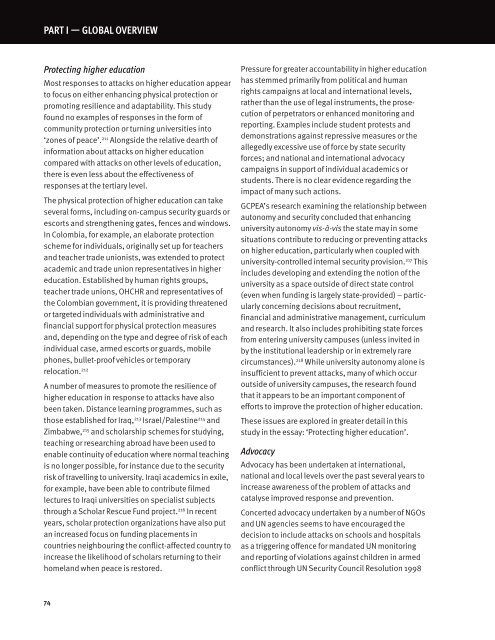eua_2014_full.pdf?utm_content=buffer4a392&utm_medium=social&utm_source=twitter
eua_2014_full.pdf?utm_content=buffer4a392&utm_medium=social&utm_source=twitter
eua_2014_full.pdf?utm_content=buffer4a392&utm_medium=social&utm_source=twitter
- No tags were found...
You also want an ePaper? Increase the reach of your titles
YUMPU automatically turns print PDFs into web optimized ePapers that Google loves.
PART I — GLOBAL OveRvIeWProtecting higher educationMost responses to attacks on higher education appearto focus on either enhancing physical protection orpromoting resilience and adaptability. This studyfound no examples of responses in the form ofcommunity protection or turning universities into‘zones of peace’. 211 Alongside the relative dearth ofinformation about attacks on higher educationcompared with attacks on other levels of education,there is even less about the effectiveness ofresponses at the tertiary level.The physical protection of higher education can takeseveral forms, including on-campus security guards orescorts and strengthening gates, fences and windows.In Colombia, for example, an elaborate protectionscheme for individuals, originally set up for teachersand teacher trade unionists, was extended to protectacademic and trade union representatives in highereducation. Established by human rights groups,teacher trade unions, OHCHR and representatives ofthe Colombian government, it is providing threatenedor targeted individuals with administrative andfinancial support for physical protection measuresand, depending on the type and degree of risk of eachindividual case, armed escorts or guards, mobilephones, bullet-proof vehicles or temporaryrelocation. 212A number of measures to promote the resilience ofhigher education in response to attacks have alsobeen taken. Distance learning programmes, such asthose established for Iraq, 213 Israel/Palestine 214 andZimbabwe, 215 and scholarship schemes for studying,teaching or researching abroad have been used toenable continuity of education where normal teachingis no longer possible, for instance due to the securityrisk of travelling to university. Iraqi academics in exile,for example, have been able to contribute filmedlectures to Iraqi universities on specialist subjectsthrough a Scholar Rescue Fund project. 216 In recentyears, scholar protection organizations have also putan increased focus on funding placements incountries neighbouring the conflict-affected country toincrease the likelihood of scholars returning to theirhomeland when peace is restored.Pressure for greater accountability in higher educationhas stemmed primarily from political and humanrights campaigns at local and international levels,rather than the use of legal instruments, the prosecutionof perpetrators or enhanced monitoring andreporting. Examples include student protests anddemonstrations against repressive measures or theallegedly excessive use of force by state securityforces; and national and international advocacycampaigns in support of individual academics orstudents. There is no clear evidence regarding theimpact of many such actions.GCPEA’s research examining the relationship betweenautonomy and security concluded that enhancinguniversity autonomy vis-à-vis the state may in somesituations contribute to reducing or preventing attackson higher education, particularly when coupled withuniversity-controlled internal security provision. 217 Thisincludes developing and extending the notion of theuniversity as a space outside of direct state control(even when funding is largely state-provided) – particularlyconcerning decisions about recruitment,financial and administrative management, curriculumand research. It also includes prohibiting state forcesfrom entering university campuses (unless invited inby the institutional leadership or in extremely rarecircumstances). 218 While university autonomy alone isinsufficient to prevent attacks, many of which occuroutside of university campuses, the research foundthat it appears to be an important component ofefforts to improve the protection of higher education.These issues are explored in greater detail in thisstudy in the essay: ‘Protecting higher education’.AdvocacyAdvocacy has been undertaken at international,national and local levels over the past several years toincrease awareness of the problem of attacks andcatalyse improved response and prevention.Concerted advocacy undertaken by a number of NGOsand UN agencies seems to have encouraged thedecision to include attacks on schools and hospitalsas a triggering offence for mandated UN monitoringand reporting of violations against children in armedconflict through UN Security Council Resolution 199874


